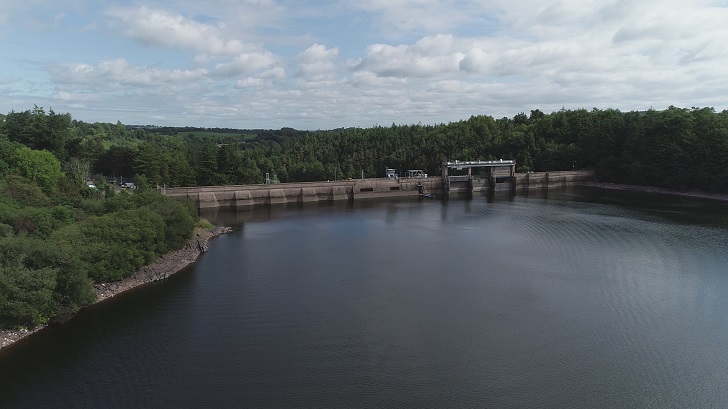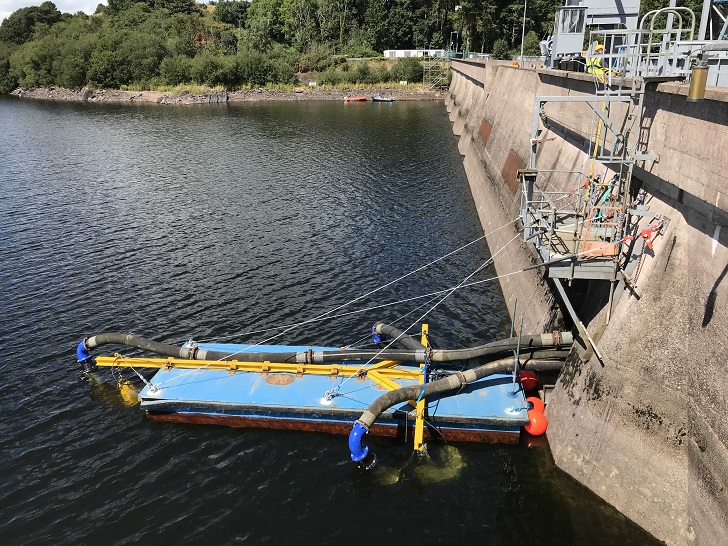

Low rainfalls around the world in 2019 meant low water levels. In Ireland, Campion Pumps were requested to find a solution to maintain the water flow at the Inniscarra Dam.
The summer of 2018 will be remembered as one of Ireland’s hottest and driest. The exceptionally dry weather reduced water levels to a varying degree across the country and this, in turn, impacted on Irish Water’s ability to abstract sufficient quantities to meet demand. The effect of severe drought was kicking in. The met station at Cork Airport, for example, recorded the lowest level of rainfall since 1962 for the combined months of June, July and August.
This lack of rainfall during the summer caused the impoundment at the Inniscarra Dam to fall to levels not previously recorded in the history of the Cork Harbour & City scheme. The Inniscarra water treatment plant was constructed in the 1970s and is the third largest such facility in the country, producing approximately 60 million litres per day.
This serves about half the needs of Cork City and surrounding areas, with plants at Lee Road and Glashaboy providing a further 40 million and 20 million litres per day respectively. Water is supplied to a population of 250,000 plus significant institutional, commercial and industrial customers.
Dam construction The impoundment at Inniscarra was formed more than two decades before the water supply scheme was introduced. During the 1950s the electricity operating company in the Republic of Ireland, the ESB Group, progressed the construction of the River Lee Hydroelectric scheme. This development comprises of dams and power stations at Carrigadrohid and Inniscarra.
ESB own and operate the hydroelectric scheme, including the reservoirs that were created behind the two dams. When the Cork Harbour & City water supply scheme began abstracting water from the impoundment, arrangements were made to facilitate the appropriate sharing of the resource.
This included the requirement, in times of extreme low reservoir levels, for the operators of the water supply scheme to provide a compensation flow by discharging a continuous minimum volume to the River Lee downstream of the Inniscarra dam.
Power turbines In normal circumstances, ESB discharge water from the reservoir through the power turbines or via three spillways. However, this ability to discharge by gravity diminishes as the head of water behind the turbines is not sufficient and the water level is at or below the crest of the spillway weirs.
This would mean that water couldn’t pass the dam and would need to be brought around the structure to keep the River Lee flowing. Although it came close on a number of occasions in the previous 40 years of operating the water supply scheme, the requirement to provide compensation flows became a reality for the first time in the summer of 2018.
Infrastructure to cater for the compensation flow was provided in the original development of the water treatment plant. It was intended to abstract the compensation volumes at the water intake, pump to the high-level balancing tanks and bypass the treatment process to discharge to the river via pipework downstream of the dam.
However, having not been utilised in the intervening decades, the condition and capacity of key elements of this system presented significant risks of failure. It was therefore necessary that an alternative approach would be required if compensation flows were to be provided.
Low levels Water levels were being monitored closely from the middle of June and by mid July the rate of reduction in the reservoir had increased to 50 mm per day. With the trigger level approaching and no substantial rain forecast Irish Water engaged Campion Pumps to develop for an alternative mechanism to provide compensation flows. After assessing a number of options, implementation began on a floating pump arrangement discharging directly into an opening in the centre of the dam, an opening normally used to pass fish.
When the concept was developed, a team of Campions specialist engineers were assembled, and preparations took place during the last week of July and over a busy August bank holiday weekend. Insurances, permits and legal arrangements were put in place and agreed with ESB. Detailed method statements and risk assessments were prepared, reviewed and revised.
High flow at low head
A 16 tonne steel plate pontoon was procured from a site in Moneypoint, Co. Clare and transported to Campion Pumps headquarters in Gortnahoe, Co. Tipperary for modifications and certification. Three pumps to cater for high flow at low head were sourced, one in Belfast and two in Nottingham. A steel frame was designed and fabricated to sit on the pontoon and hold the pumps in position. Within a two-week period, the elements were brought together and lifted into the water at Inniscarra to be floated into position at the centre of the dam.
Three 12 in delivery pipework were passed through the opening and the pontoon was secured using four anchor points that had been drilled into the upstream face of the dam. A 300 kVA diesel generator provided the power and with soft starts and control panels in place, the pumps were commissioned on 9 August. The required discharge rate of 1.5 m3/s to the downstream channel was achieved.
It took an enormous collective approach to successfully mobilise these works. ESB and Irish Water worked jointly to manage all of the issues involved and, in a focussed hands-on way, co-ordinated the projects implementation. The main contractor involved was Campion Pumps, who managed the design, assembly and delivery of the overall project. Subsea Marine and WH Scott ensured the safe positioning of the pontoon over the water.
Key support Cork County Council staff at the Inniscarra treatment plant provided key support and worked on back-up arrangements to provide partial compensation flow via the original route and an alternative scour pipe. Cork City Council staff put in place measures to maximise production at the Lee Road plant and push water into areas normally fed from Inniscarra, thereby extending the availability of raw water.
The pontoon pumping arrangement remained in operation for six weeks. By meeting the requirement to provide compensation flows, Irish Water ensured continued access to raw water at Inniscarra. By providing a minimum flow in the River Lee channel, the arrangement also facilitated continued abstraction at the downstream Lee Road plant and supported the health of the river and sustaining fish life.
A national hose-pipe ban was in place at the time, and aside from this, all customers served by the water supplies were unaffected. Levels started to recover during September and, with the benefit of good rainfall forecast, the decision was made to begin demobilisation. The pontoon was removed from position and anchored safely at shore on 17 September just before Storm Ali began to track over the country, the first storm of the season named jointly by Met Éireann and the UK met office.






